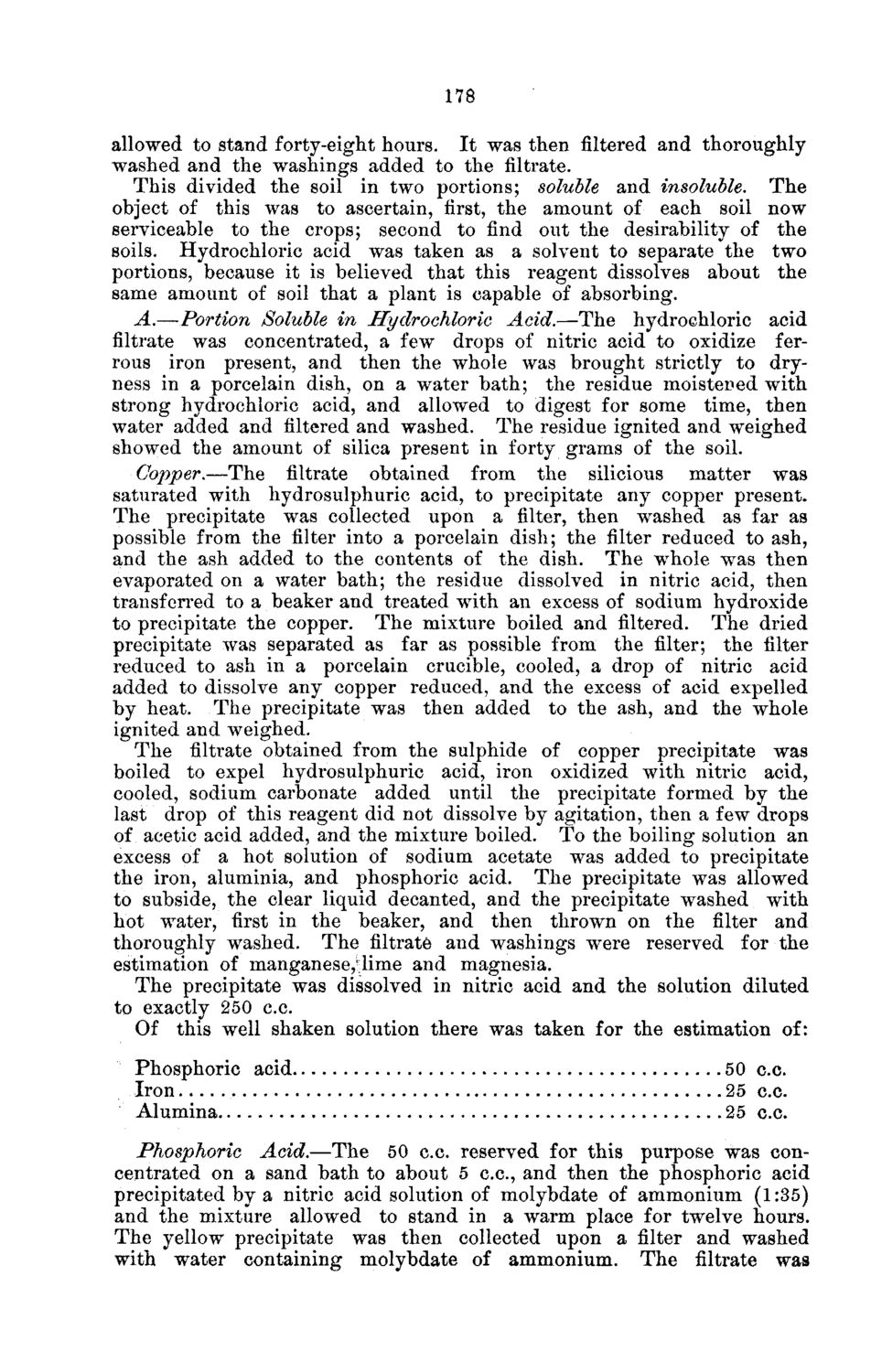| |
| |
Caption: Board of Trustees Minutes - 1878
This is a reduced-resolution page image for fast online browsing.

EXTRACTED TEXT FROM PAGE:
178 allowed to stand forty-eight hours. I t was then filtered and thoroughly washed and the washings added to the filtrate. This divided the soil in two portions; soluble and insoluble. The object of this was to ascertain, first, the amount of each soil now serviceable to the crops; second to find out the desirability of the soils. Hydrochloric acid was taken as a solvent to separate the two portions, because it is believed that this reagent dissolves about the same amount of soil that a plant is capable of absorbing. A.—Portion Soluble in Hydrochloric Acid.—The hydrochloric acid filtrate was concentrated, a few drops of nitric acid to oxidize ferrous iron present, and then the whole was brought strictly to dryness in a porcelain dish, on a water bath; the residue moistened with strong hydrochloric acid, and allowed to digest for some time, then water added and filtered and washed. The residue ignited and weighed showed the amount of silica present in forty grams of the soil. Copper.—The filtrate obtained from the silicious matter was saturated with hydrosulphuric acid, to precipitate any copper present. The precipitate was collected upon a filter, then washed as far as possible from the filter into a porcelain dish; the filter reduced to ash, and the ash added to the contents of the dish. T h e whole was then evaporated on a water bath; the residue dissolved in nitric acid, then transferred to a beaker and treated with an excess of sodium hydroxide to precipitate the copper. The mixture boiled and filtered. The dried precipitate was separated as far as possible from the filter; the filter reduced to ash in a porcelain crucible, cooled, a drop of nitric acid added to dissolve any copper reduced, and the excess of acid expelled by heat. The precipitate was then added to the ash, and the whole ignited and weighed. The filtrate obtained from the sulphide of copper precipitate was boiled to expel hydrosulphuric acid, iron oxidized with nitric acid, cooled, sodium carbonate added until the precipitate formed by the last drop of this reagent did not dissolve by agitation, then a few drops of acetic acid added, and the mixture boiled. To the boiling solution an excess of a hot solution of sodium acetate was added to precipitate the iron, aluminia, and phosphoric acid. The precipitate was allowed to subside, the clear liquid decanted, and the precipitate washed with hot water, first in the beaker, and then thrown on the filter and thoroughly washed. The filtrate and washings were reserved for the estimation of manganese,Uime and magnesia. The precipitate was dissolved in nitric acid and the solution diluted to exactly 250 c.c. Of this well shaken solution there was taken for the estimation of: Phosphoric acid Iron Alumina 50 c.c. 25 c.c. 25 c.c. Phosphoric Acid.—The 50 c.c. reserved for this purpose was concentrated on a sand bath to about 5 c.c, and then the phosphoric acid precipitated by a nitric acid solution of molybdate of ammonium (1:35) and the mixture allowed to stand in a warm place for twelve hours. The yellow precipitate was then collected upon a filter and washed with water containing molybdate of ammonium. The filtrate was
| |